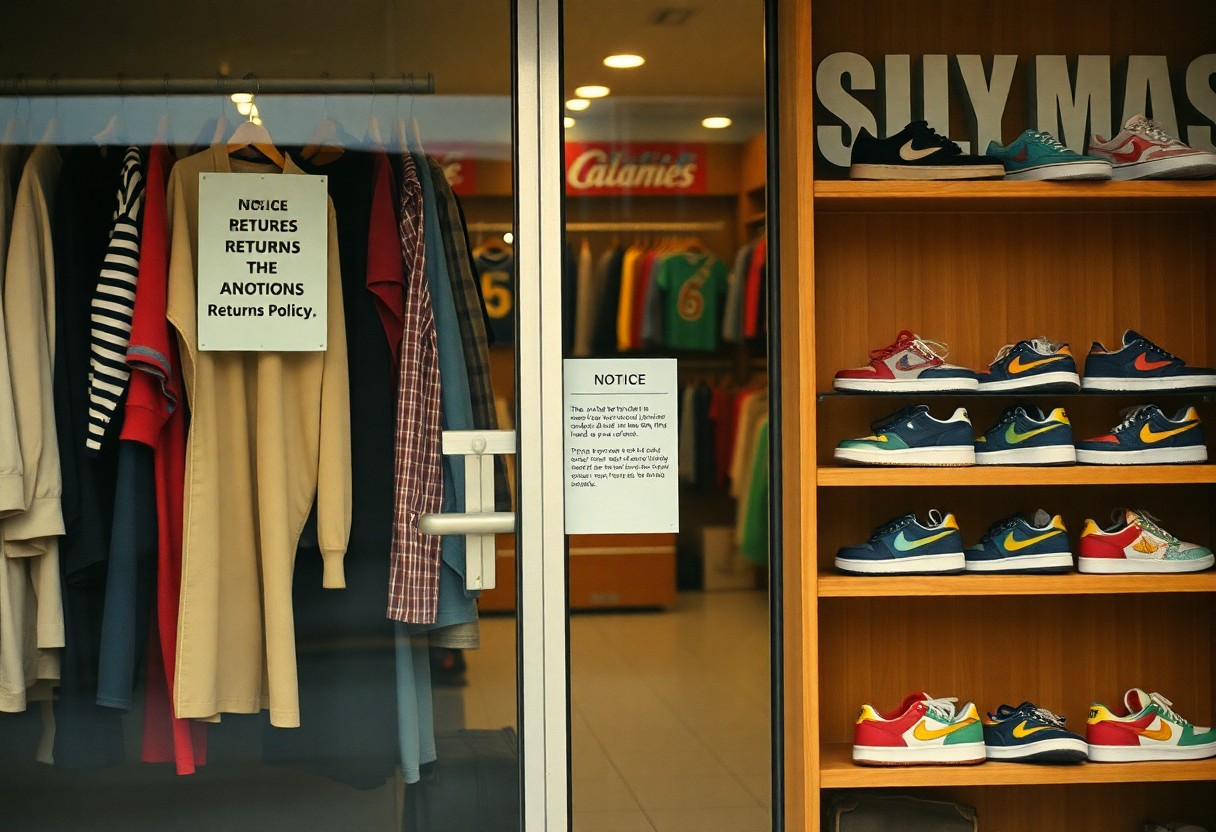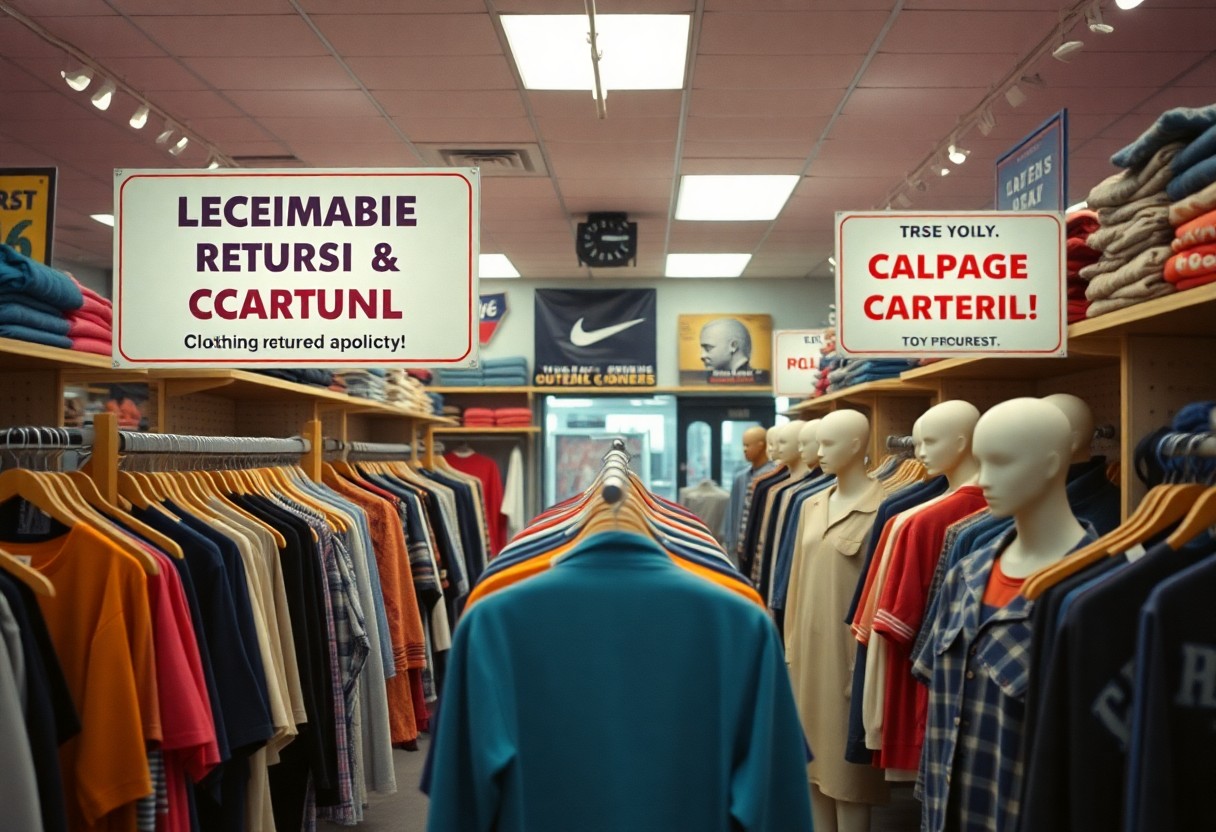Returns are an imperative aspect of your shopping experience, especially with 80s casual classics. Understanding the specific conditions for returns can save you from potential disappointments. Ensure that items are unworn and in their original packaging to qualify for a full refund. Be mindful of the time limits set by the retailer, as these vary and can impact your return process. Knowing these details empowers you to make informed purchases and enjoy your retro apparel without worry.

The Nostalgic Allure of 80s Casual Classics
Style Evolution: How the 80s Defined Casual Fashion
The 1980s marked a transformative period in fashion, where casual wear emerged as a cultural statement. This decade saw the blend of comfort and style, creating a shift towards relaxed silhouettes and vibrant colors. The rise of television and music influences, particularly from MTV, opened avenues for self-expression through fashion, with celebrities and musicians becoming style icons. You witnessed an intriguing mix of elements, like oversized blazers paired with graphic tees, denim, and tracksuits becoming staples of everyday wear.
As the decade progressed, casual fashion evolved to include bold patterns, accessories, and innovative materials. Street style began to gain prominence, reflecting the youth culture and lifestyle of the time. You’d find yourself drawn to comfortable yet expressive pieces that showcased individuality. The juxtaposition of polished and laid-back looks allowed for an exploration of personal style that continues to influence fashion today.
Icons of the Era: Key Pieces That Shaped the Look
Essentials of the 80s casual wardrobe include iconic pieces such as high-waisted jeans, windbreakers, and slouchy sweaters. The popularity of brands like Levi’s and Champion defined the staples of your closet, with each piece carrying its own cultural weight. You likely found yourself donning brightly colored sneakers, a reflection of the decade’s cheerfulness and spontaneity, while accessories like scrunchies and neon legwarmers added flair to your outfit.
Tracksuits emerged as a symbol of casual luxury, often linked to athletic figures and the booming fitness culture of the era. Pieces from brands like Adidas and Nike were not just for workouts; they became everyday attire. This crossover of functionality and fashion solidified your wardrobe choices, creating a lasting legacy that resonates in contemporary styles.
The era also celebrated the impact of music and film on fashion. Movies such as “Fast Times at Ridgemont High” and artists like Madonna and Prince set trends that you might have eagerly emulated. These pieces transitioned from the screen and stage to your everyday life, making them not just clothing but also relics of a cultural movement. The nostalgia surrounding these styles continues to foster a connection between you and the vibrant spirit of the 80s.
Navigating Returns: Ensuring Satisfaction in a Vintage Market
Understanding the Unique Challenges of Retro Apparel Returns
Your customers may face unexpected issues when buying retro apparel, especially with unique sizing and fabric variations. Vintage pieces often come from different eras that adopted distinct measurement standards, leading to confusion. For instance, a size labeled ‘medium’ in the 80s may not equate to the same size today, causing potential dissatisfaction upon arrival. Additionally, garments may show signs of wear that aren’t immediately apparent in product photos, impacting customer expectations.
These challenges necessitate a comprehensive understanding of the vintage market and its nuances. Highlighting the condition of each item, including any imperfections, can mitigate returns due to mismatched expectations. Implementing clearer measurement guidelines tailored for retro items can also enhance customer confidence, as they can make more informed choices aligned with their personal style and fit preferences.
Crafting a Consumer-Friendly Returns Policy
Your returns policy should reflect an understanding of the unique challenges inherent to vintage shopping. Clear, straightforward return guidelines enhance customer trust and satisfaction. Offering a reasonable return window, such as 14 to 30 days, gives you the flexibility to manage returns while accommodating those who may need extra time to decide. Consider providing a prepaid return label or free return shipping for exchanges, as this can significantly boost customer loyalty.
Incorporate specific terms that cater to vintage items, like emphasizing ‘exchanges only’ for certain one-of-a-kind pieces, while allowing returns on newer reproductions. Clear communication about your policy can ease anxiety for first-time retro shoppers and encourage more purchases, knowing they can return items that don’t meet expectations. Including key visual indicators about sizing directly on your online store can further enhance user experience, leading to reduced returns.

The Financial Impact of an Accommodating Returns Policy
Balancing Customer Happiness with Financial Viability
An accommodating returns policy can significantly enhance customer satisfaction, leading to increased sales and repeat purchases. Data from businesses with flexible return options show that customers are 60% more likely to complete a purchase when they are assured of an easy return process. However, your company must also remain vigilant about the financial implications of such policies. Returns can increase operational costs, so establishing a limit on the time frame and conditions for returns can help maintain a balance between customer satisfaction and financial sustainability.
Implementing strategies like restocking fees on returned items or offering store credit instead of full refunds can mitigate financial losses while still conveying a customer-first approach. By analyzing return trends and customer feedback, you can refine your policy to ensure it meets customer needs without straining your bottom line.
Long-Term Benefits of Building Trust with Customers
Trust is a cornerstone of customer loyalty, and a well-structured returns policy fosters that trust. You will likely see a direct correlation between easy returns and customer retention rates. According to a survey conducted by a leading retail research firm, 93% of customers said they are more likely to shop with a brand that offers hassle-free returns. This means that while immediate financial impacts might appear negative, you’re investing in future sales and loyal customer relationships.
Over time, this trust translates into higher customer lifetime values. As customers develop confidence in your brand, they are more inclined to make larger purchases, recommend your store to others, and engage with your products on social media platforms. Establishing a favorable returns policy demonstrates that you care about your customers’ experiences, ultimately leading to greater long-term financial stability even amidst potential short-term return expenses.
Analyzing Customer Feedback: Enhancing the Returns Experience
Using Testimonials to Refine Policy Effectiveness
Your customer testimonials serve as a goldmine of insights for refining the returns policy. When customers share their experiences, they provide direct feedback on what aspects of the return process worked well and what didn’t. By actively seeking out these testimonials—you might find that customers appreciate quick turnaround times or user-friendly return labels. This feedback can inform targeted improvements in your policy, increasing overall satisfaction and loyalty.
Highlighting positive testimonials on your website can also instill confidence among potential buyers. A potential customer might feel reassured knowing that previous customers had a seamless experience returning items. Including a section dedicated to customer stories not only validates your brand’s reliability but can also guide your future policy adjustments based on consistent themes in feedback.
Metrics for Success: Evaluating Returns Data
Tracking returns data provides invaluable insights into patterns and potential areas for improvement. Key metrics such as return rates, reasons for returns, and the time taken to process returns are important. For instance, if you notice a spike in returns for a specific vintage item, it’s vital to investigate whether sizing issues or item descriptions are misleading. This data allows you to implement necessary changes to reduce future returns, enhancing both customer satisfaction and your bottom line.
Analyzing returns data over time helps you identify trends and make strategic decisions. For example, if a vintage jacket consistently has a high return rate, consider revising the product description or adding a size chart to clarify fit. Establishing a regular review process for these metrics ensures your returns policy remains effective, ultimately leading to a smoother shopping experience for your customers.
Contemporary Trends Influencing Returns in the Casual Classics Market
The Rise of Sustainability and Its Impact on Returns
Growing consumer awareness regarding sustainability directly affects return behaviors in the casual classics market. Your customers are increasingly prioritizing eco-friendly brands, which drives the demand for products made with sustainable materials and ethical manufacturing processes. As a result, brands that do not align with these values face higher return rates, particularly when products do not meet customer expectations related to quality or environmental impact. Offering clear information on sustainable practices can help mitigate returns, as informed customers may be more likely to keep items that align with their values.
Furthermore, the challenge of waste in fast fashion leads many consumers to carefully consider their purchases, opting for fewer, higher-quality items. In this evolving landscape, fair practices in returns—like minimizing waste through refurbished items or recycling programs—can enhance brand loyalty and reduce return rates. Your returns policy must reflect these shifts, promoting a culture of sustainability and accommodating customers’ eco-conscious choices.
How Technology is Reshaping Returns Processes
Technology increasingly simplifies the returns process, providing customers with user-friendly solutions that enhance convenience. Digital tools enable customers to easily initiate returns via mobile apps or websites, offering features such as instant refund options and AI-driven assistance. For example, companies like Zappos have streamlined their returns process, allowing you to print return labels directly from your account, making the experience more seamless and efficient. These advancements not only increase customer satisfaction but also minimize property loss due to unnecessary returns.
Adopting enhanced data analytics can give you deeper insights into return patterns and customer preferences, allowing for better inventory management and targeted marketing. Machine learning algorithms can identify common return reasons, helping you address issues before they escalate. By leveraging technology, you can create a more adaptable returns policy that responds dynamically to customer needs, ultimately leading to reduced returns and heightened customer loyalty.
To wrap up
Ultimately, understanding the returns policy for 80s casual classics ensures that you have a smooth shopping experience. With the right information, you can make confident purchasing decisions, knowing that if an item doesn’t meet your expectations, you have the option to return it. Be sure to familiarize yourself with the specific terms, such as time frames and conditions for returns, to avoid any surprises.
Your satisfaction is important, and a well-structured returns policy reflects a commitment to quality and customer service. By following the outlined procedures, you can feel secure in your choices and enjoy the nostalgic flair of 80s casual classics without any added stress. Taking these steps will not only enhance your shopping experience but also allow you to relish the unique styles of this iconic era.
FAQ
Q: What items are eligible for return under the 80s Casual Classics returns policy?
A: Items that are unwanted or defective can be returned. All returns must be in their original packaging and in a resalable condition. Some exclusions may apply to sale items or specific merchandise.
Q: How do I initiate a return for my 80s Casual Classics purchase?
A: To initiate a return, contact our customer service team within 30 days of receiving your item. Provide your order number and reason for the return. You will then receive instructions on how to proceed with shipping the item back.
Q: Will I be refunded the full amount for my returned items?
A: Refunds will include the original purchase price, but shipping costs may not be refunded unless the return is due to a mistake on our part. Refunds will be processed within 7-10 business days after the returned item is received and inspected.